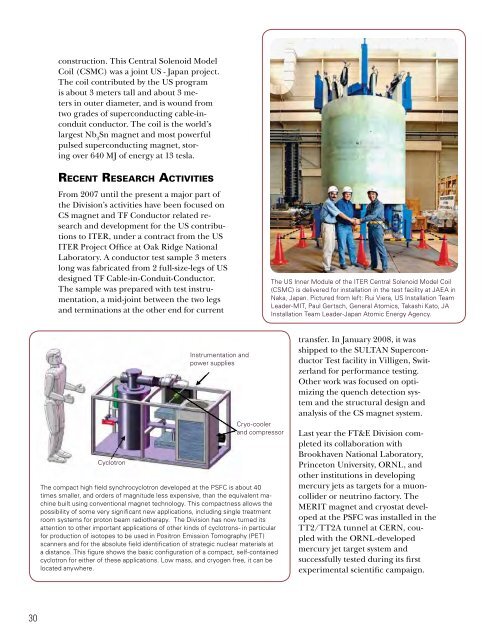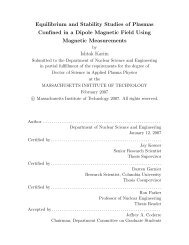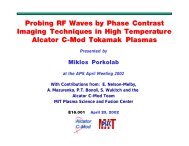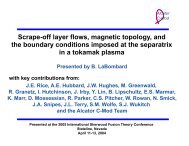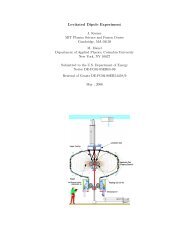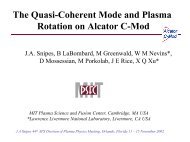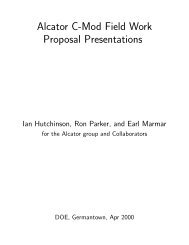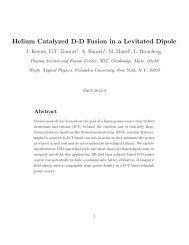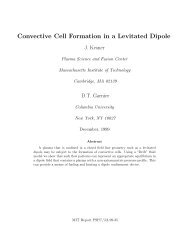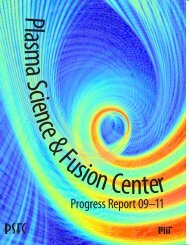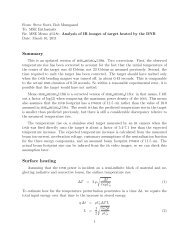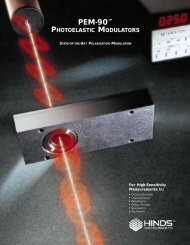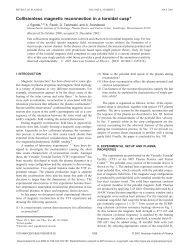From the Director - Plasma Science and Fusion Center - MIT
From the Director - Plasma Science and Fusion Center - MIT
From the Director - Plasma Science and Fusion Center - MIT
Create successful ePaper yourself
Turn your PDF publications into a flip-book with our unique Google optimized e-Paper software.
construction. This Central Solenoid Model<br />
Coil (CSMC) was a joint US - Japan project.<br />
The coil contributed by <strong>the</strong> US program<br />
is about 3 meters tall <strong>and</strong> about 3 meters<br />
in outer diameter, <strong>and</strong> is wound from<br />
two grades of superconducting cable-inconduit<br />
conductor. The coil is <strong>the</strong> world’s<br />
largest Nb 3<br />
Sn magnet <strong>and</strong> most powerful<br />
pulsed superconducting magnet, storing<br />
over 640 MJ of energy at 13 tesla.<br />
Recent Research Activities<br />
<strong>From</strong> 2007 until <strong>the</strong> present a major part of<br />
<strong>the</strong> Division’s activities have been focused on<br />
CS magnet <strong>and</strong> TF Conductor related research<br />
<strong>and</strong> development for <strong>the</strong> US contributions<br />
to ITER, under a contract from <strong>the</strong> US<br />
ITER Project Office at Oak Ridge National<br />
Laboratory. A conductor test sample 3 meters<br />
long was fabricated from 2 full-size-legs of US<br />
designed TF Cable-in-Conduit-Conductor.<br />
The sample was prepared with test instrumentation,<br />
a mid-joint between <strong>the</strong> two legs<br />
<strong>and</strong> terminations at <strong>the</strong> o<strong>the</strong>r end for current<br />
The US Inner Module of <strong>the</strong> ITER Central Solenoid Model Coil<br />
(CSMC) is delivered for installation in <strong>the</strong> test facility at JAEA in<br />
Naka, Japan. Pictured from left: Rui Viera, US Installation Team<br />
Leader-<strong>MIT</strong>, Paul Gertsch, General Atomics, Takashi Kato, JA<br />
Installation Team Leader-Japan Atomic Energy Agency.<br />
Cyclotron<br />
Instrumentation <strong>and</strong><br />
power supplies<br />
Cryo-cooler<br />
<strong>and</strong> compressor<br />
The compact high field synchrocyclotron developed at <strong>the</strong> PSFC is about 40<br />
times smaller, <strong>and</strong> orders of magnitude less expensive, than <strong>the</strong> equivalent machine<br />
built using conventional magnet technology. This compactness allows <strong>the</strong><br />
possibility of some very significant new applications, including single treatment<br />
room systems for proton beam radio<strong>the</strong>rapy. The Division has now turned its<br />
attention to o<strong>the</strong>r important applications of o<strong>the</strong>r kinds of cyclotrons- in particular<br />
for production of isotopes to be used in Positron Emission Tomography (PET)<br />
scanners <strong>and</strong> for <strong>the</strong> absolute field identification of strategic nuclear materials at<br />
a distance. This figure shows <strong>the</strong> basic configuration of a compact, self-contained<br />
cyclotron for ei<strong>the</strong>r of <strong>the</strong>se applications. Low mass, <strong>and</strong> cryogen free, it can be<br />
located anywhere.<br />
transfer. In January 2008, it was<br />
shipped to <strong>the</strong> SULTAN Superconductor<br />
Test facility in Villigen, Switzerl<strong>and</strong><br />
for performance testing.<br />
O<strong>the</strong>r work was focused on optimizing<br />
<strong>the</strong> quench detection system<br />
<strong>and</strong> <strong>the</strong> structural design <strong>and</strong><br />
analysis of <strong>the</strong> CS magnet system.<br />
Last year <strong>the</strong> FT&E Division completed<br />
its collaboration with<br />
Brookhaven National Laboratory,<br />
Princeton University, ORNL, <strong>and</strong><br />
o<strong>the</strong>r institutions in developing<br />
mercury jets as targets for a muoncollider<br />
or neutrino factory. The<br />
MERIT magnet <strong>and</strong> cryostat developed<br />
at <strong>the</strong> PSFC was installed in <strong>the</strong><br />
TT2/TT2A tunnel at CERN, coupled<br />
with <strong>the</strong> ORNL-developed<br />
mercury jet target system <strong>and</strong><br />
successfully tested during its first<br />
experimental scientific campaign.<br />
30


